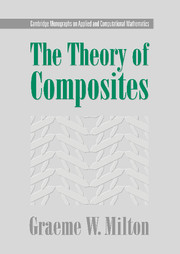Book contents
- Frontmatter
- Contents
- List of figures
- Preface
- 1 Introduction
- 2 Some equations of interest and numerical approaches to solving them
- 3 Duality transformations in two-dimensional media
- 4 Translations and equivalent media
- 5 Some microstructure-independent exact relations
- 6 Exact relations for coupled equations
- 7 Assemblages of spheres, ellipsoids, and other neutral inclusions
- 8 Tricks for generating other exactly solvable microgeometries
- 9 Laminate materials
- 10 Approximations and asymptotic formulas
- 11 Wave propagation in the quasistatic limit
- 12 Reformulating the problem of finding effective tensors
- 13 Variational principles and inequalities
- 14 Series expansions for the fields and effective tensors
- 15 Correlation functions and how they enter series expansions†
- 16 Other perturbation solutions
- 17 The general theory of exact relations and links between effective tensors
- 18 Analytic properties
- 19 Y-tensors
- 20 Y-tensors and effective tensors in electrical circuits†
- 21 Bounds on the properties of composites
- 22 Classical variational principle bounds
- 23 Bounds from the Hashin-Shtrikman variational inequalities
- 24 Bounds using the compensated compactness or translation method
- 25 Choosing the translations and finding microgeometries that attain the bounds†
- 26 Bounds incorporating three-point correlation functions†
- 27 Bounds using the analytic method
- 28 Fractional linear transformations as a tool for generating bounds†
- 29 The field equation recursion method†
- 30 Properties of the G-closure and extremal families of composites
- 31 The bounding of effective moduli as a quasiconvexification problem
- Author index
- Subject index
25 - Choosing the translations and finding microgeometries that attain the bounds†
- Frontmatter
- Contents
- List of figures
- Preface
- 1 Introduction
- 2 Some equations of interest and numerical approaches to solving them
- 3 Duality transformations in two-dimensional media
- 4 Translations and equivalent media
- 5 Some microstructure-independent exact relations
- 6 Exact relations for coupled equations
- 7 Assemblages of spheres, ellipsoids, and other neutral inclusions
- 8 Tricks for generating other exactly solvable microgeometries
- 9 Laminate materials
- 10 Approximations and asymptotic formulas
- 11 Wave propagation in the quasistatic limit
- 12 Reformulating the problem of finding effective tensors
- 13 Variational principles and inequalities
- 14 Series expansions for the fields and effective tensors
- 15 Correlation functions and how they enter series expansions†
- 16 Other perturbation solutions
- 17 The general theory of exact relations and links between effective tensors
- 18 Analytic properties
- 19 Y-tensors
- 20 Y-tensors and effective tensors in electrical circuits†
- 21 Bounds on the properties of composites
- 22 Classical variational principle bounds
- 23 Bounds from the Hashin-Shtrikman variational inequalities
- 24 Bounds using the compensated compactness or translation method
- 25 Choosing the translations and finding microgeometries that attain the bounds†
- 26 Bounds incorporating three-point correlation functions†
- 27 Bounds using the analytic method
- 28 Fractional linear transformations as a tool for generating bounds†
- 29 The field equation recursion method†
- 30 Properties of the G-closure and extremal families of composites
- 31 The bounding of effective moduli as a quasiconvexification problem
- Author index
- Subject index
Summary
The main difficulty in applying the translation method is in choosing the translation T. This is intimately tied with the question of what microgeometries attain a given bound, since one typically wants to choose the translations so that the resulting bounds are attained by at least some microgeometries. This chapter addresses these two issues.
Other derivations of the translation bounds and their extension to nonlinear problems
The argument leading to the translation bounds (24.17) is appealing because it gives an interpretation of the bounds in terms of the harmonic mean bounds applied to the translated medium. Also, as will be discussed later in section 26.5 on page 560, one immediately sees that tighter correlation function dependent bounds could be used instead of the harmonic mean bounds. However, it is somewhat mysterious as it does not explain why it is natural to consider bounds on the translated medium in the first place. Both the compensated compactness approach (Tartar 1979a, 1979b, 1985; Murat and Tartar 1985; Murat 1987) and the variational approach (Lurie and Cherkaev 1982, 1984 1986; Gibiansky and Cherkaev 1984; Firoozye 1991) provide this insight.
In the compensated compactness approach, which is outlined in theorem 8 in the paper of Tartar (1979b), one seeks to find the possible values of the average field pair (〈E〉, 〈J〉) given the differential constraints on the fields and given that the fields satisfy the constitutive relation.
- Type
- Chapter
- Information
- The Theory of Composites , pp. 529 - 552Publisher: Cambridge University PressPrint publication year: 2002



